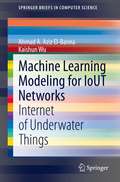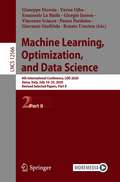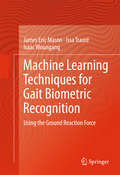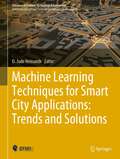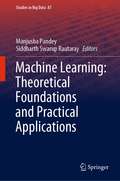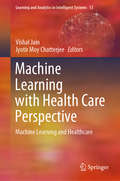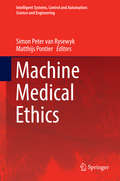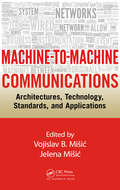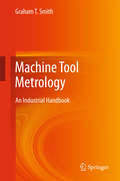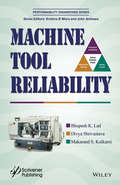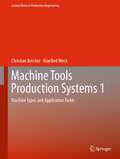- Table View
- List View
Machine Learning in VLSI Computer-Aided Design
by Duane S. Boning Xin Li Ibrahim Abe ElfadelThis book provides readers with an up-to-date account of the use of machine learning frameworks, methodologies, algorithms and techniques in the context of computer-aided design (CAD) for very-large-scale integrated circuits (VLSI). Coverage includes the various machine learning methods used in lithography, physical design, yield prediction, post-silicon performance analysis, reliability and failure analysis, power and thermal analysis, analog design, logic synthesis, verification, and neuromorphic design. Provides up-to-date information on machine learning in VLSI CAD for device modeling, layout verifications, yield prediction, post-silicon validation, and reliability;Discusses the use of machine learning techniques in the context of analog and digital synthesis;Demonstrates how to formulate VLSI CAD objectives as machine learning problems and provides a comprehensive treatment of their efficient solutions;Discusses the tradeoff between the cost of collecting data and prediction accuracy and provides a methodology for using prior data to reduce cost of data collection in the design, testing and validation of both analog and digital VLSI designs. From the Foreword As the semiconductor industry embraces the rising swell of cognitive systems and edge intelligence, this book could serve as a harbinger and example of the osmosis that will exist between our cognitive structures and methods, on the one hand, and the hardware architectures and technologies that will support them, on the other….As we transition from the computing era to the cognitive one, it behooves us to remember the success story of VLSI CAD and to earnestly seek the help of the invisible hand so that our future cognitive systems are used to design more powerful cognitive systems. This book is very much aligned with this on-going transition from computing to cognition, and it is with deep pleasure that I recommend it to all those who are actively engaged in this exciting transformation. Dr. Ruchir Puri, IBM Fellow, IBM Watson CTO & Chief Architect, IBM T. J. Watson Research Center
Machine Learning Methods for Behaviour Analysis and Anomaly Detection in Video (Springer Theses)
by Olga IsupovaThis thesis proposes machine learning methods for understanding scenes via behaviour analysis and online anomaly detection in video. The book introduces novel Bayesian topic models for detection of events that are different from typical activities and a novel framework for change point detection for identifying sudden behavioural changes.Behaviour analysis and anomaly detection are key components of intelligent vision systems. Anomaly detection can be considered from two perspectives: abnormal events can be defined as those that violate typical activities or as a sudden change in behaviour. Topic modelling and change-point detection methodologies, respectively, are employed to achieve these objectives.The thesis starts with the development of learning algorithms for a dynamic topic model, which extract topics that represent typical activities of a scene. These typical activities are used in a normality measure in anomaly detection decision-making. The book also proposes a novel anomaly localisation procedure. In the first topic model presented, a number of topics should be specified in advance. A novel dynamic nonparametric hierarchical Dirichlet process topic model is then developed where the number of topics is determined from data. Batch and online inference algorithms are developed.The latter part of the thesis considers behaviour analysis and anomaly detection within the change-point detection methodology. A novel general framework for change-point detection is introduced. Gaussian process time series data is considered. Statistical hypothesis tests are proposed for both offline and online data processing and multiple change point detection are proposed and theoretical properties of the tests are derived. The thesis is accompanied by open-source toolboxes that can be used by researchers and engineers.
Machine Learning Methods for Reverse Engineering of Defective Structured Surfaces (Schriftenreihe der Institute für Systemdynamik (ISD) und optische Systeme (IOS))
by Pascal LaubePascal Laube presents machine learning approaches for three key problems of reverse engineering of defective structured surfaces: parametrization of curves and surfaces, geometric primitive classification and inpainting of high-resolution textures. The proposed methods aim to improve the reconstruction quality while further automating the process. The contributions demonstrate that machine learning can be a viable part of the CAD reverse engineering pipeline.
Machine Learning Modeling for IoUT Networks: Internet of Underwater Things (SpringerBriefs in Computer Science)
by Ahmad A. Aziz El-Banna Kaishun WuThis book discusses how machine learning and the Internet of Things (IoT) are playing a part in smart control of underwater environments, known as Internet of Underwater Things (IoUT). The authors first present seawater’s key physical variables and go on to discuss opportunistic transmission, localization and positioning, machine learning modeling for underwater communication, and ongoing challenges in the field. In addition, the authors present applications of machine learning techniques for opportunistic communication and underwater localization. They also discuss the current challenges of machine learning modeling of underwater communication from two communication engineering and data science perspectives.
Machine Learning, Optimization, and Data Science: 6th International Conference, LOD 2020, Siena, Italy, July 19–23, 2020, Revised Selected Papers, Part II (Lecture Notes in Computer Science #12566)
by Giuseppe Nicosia Varun Ojha Emanuele La Malfa Giorgio Jansen Vincenzo Sciacca Panos Pardalos Giovanni Giuffrida Renato UmetonThis two-volume set, LNCS 12565 and 12566, constitutes the refereed proceedings of the 6th International Conference on Machine Learning, Optimization, and Data Science, LOD 2020, held in Siena, Italy, in July 2020. The total of 116 full papers presented in this two-volume post-conference proceedings set was carefully reviewed and selected from 209 submissions. These research articles were written by leading scientists in the fields of machine learning, artificial intelligence, reinforcement learning, computational optimization, and data science presenting a substantial array of ideas, technologies, algorithms, methods, and applications.
Machine Learning Paradigms: Advances in Deep Learning-based Technological Applications (Learning and Analytics in Intelligent Systems #18)
by George A. Tsihrintzis Lakhmi C. JainAt the dawn of the 4th Industrial Revolution, the field of Deep Learning (a sub-field of Artificial Intelligence and Machine Learning) is growing continuously and rapidly, developing both theoretically and towards applications in increasingly many and diverse other disciplines. The book at hand aims at exposing its reader to some of the most significant recent advances in deep learning-based technological applications and consists of an editorial note and an additional fifteen (15) chapters. All chapters in the book were invited from authors who work in the corresponding chapter theme and are recognized for their significant research contributions. In more detail, the chapters in the book are organized into six parts, namely (1) Deep Learning in Sensing, (2) Deep Learning in Social Media and IOT, (3) Deep Learning in the Medical Field, (4) Deep Learning in Systems Control, (5) Deep Learning in Feature Vector Processing, and (6) Evaluation of Algorithm Performance. This research book is directed towards professors, researchers, scientists, engineers and students in computer science-related disciplines. It is also directed towards readers who come from other disciplines and are interested in becoming versed in some of the most recent deep learning-based technological applications. An extensive list of bibliographic references at the end of each chapter guides the readers to probe deeper into their application areas of interest.
Machine Learning Support for Fault Diagnosis of System-on-Chip
by Patrick Girard Shawn Blanton Li-C. WangThis book provides a state-of-the-art guide to Machine Learning (ML)-based techniques that have been shown to be highly efficient for diagnosis of failures in electronic circuits and systems. The methods discussed can be used for volume diagnosis after manufacturing or for diagnosis of customer returns. Readers will be enabled to deal with huge amount of insightful test data that cannot be exploited otherwise in an efficient, timely manner. After some background on fault diagnosis and machine learning, the authors explain and apply optimized techniques from the ML domain to solve the fault diagnosis problem in the realm of electronic system design and manufacturing. These techniques can be used for failure isolation in logic or analog circuits, board-level fault diagnosis, or even wafer-level failure cluster identification. Evaluation metrics as well as industrial case studies are used to emphasize the usefulness and benefits of using ML-based diagnosis techniques.
Machine Learning Techniques for Gait Biometric Recognition: Using the Ground Reaction Force
by James Eric Mason Issa Traoré Isaac WoungangThis book focuses on how machine learning techniques can be used to analyze and make use of one particular category of behavioral biometrics known as the gait biometric. A comprehensive Ground Reaction Force (GRF)-based Gait Biometrics Recognition framework is proposed and validated by experiments. In addition, an in-depth analysis of existing recognition techniques that are best suited for performing footstep GRF-based person recognition is also proposed, as well as a comparison of feature extractors, normalizers, and classifiers configurations that were never directly compared with one another in any previous GRF recognition research. Finally, a detailed theoretical overview of many existing machine learning techniques is presented, leading to a proposal of two novel data processing techniques developed specifically for the purpose of gait biometric recognition using GRF.This book· introduces novel machine-learning-based temporal normalization techniques· bridges research gaps concerning the effect of footwear and stepping speed on footstep GRF-based person recognition· provides detailed discussions of key research challenges and open research issues in gait biometrics recognition· compares biometrics systems trained and tested with the same footwear against those trained and tested with different footwear
Machine Learning Techniques for Smart City Applications: Trends and Solutions (Advances in Science, Technology & Innovation)
by D. Jude HemanthThis book discusses the application of different machine learning techniques to the sub-concepts of smart cities such as smart energy, transportation, waste management, health, infrastructure, etc. The focus of this book is to come up with innovative solutions in the above-mentioned issues with the purpose of alleviating the pressing needs of human society. This book includes content with practical examples which are easy to understand for readers. It also covers a multi-disciplinary field and, consequently, it benefits a wide readership including academics, researchers, and practitioners.
Machine Learning Technologies and Applications: Proceedings of ICACECS 2020 (Algorithms for Intelligent Systems)
by C. Kiran Mai A. Brahmananda Reddy K. Srujan RajuThis book comprises the best deliberations with the theme “Machine Learning Technologies and Applications” in the “International Conference on Advances in Computer Engineering and Communication Systems (ICACECS 2020),” organized by the Department of Computer Science and Engineering, VNR Vignana Jyothi Institute of Engineering and Technology. The book provides insights into the recent trends and developments in the field of computer science with a special focus on the machine learning and big data. The book focuses on advanced topics in artificial intelligence, machine learning, data mining and big data computing, cloud computing, Internet of things, distributed computing and smart systems.
Machine Learning: Theoretical Foundations and Practical Applications (Studies in Big Data #87)
by Manjusha Pandey Siddharth Swarup RautarayThis edited book is a collection of chapters invited and presented by experts at 10th industry symposium held during 9–12 January 2020 in conjunction with 16th edition of ICDCIT. The book covers topics, like machine learning and its applications, statistical learning, neural network learning, knowledge acquisition and learning, knowledge intensive learning, machine learning and information retrieval, machine learning for web navigation and mining, learning through mobile data mining, text and multimedia mining through machine learning, distributed and parallel learning algorithms and applications, feature extraction and classification, theories and models for plausible reasoning, computational learning theory, cognitive modelling and hybrid learning algorithms.
Machine Learning under Malware Attack
by Raphael Labaca-CastroMachine learning has become key in supporting decision-making processes across a wide array of applications, ranging from autonomous vehicles to malware detection. However, while highly accurate, these algorithms have been shown to exhibit vulnerabilities, in which they could be deceived to return preferred predictions. Therefore, carefully crafted adversarial objects may impact the trust of machine learning systems compromising the reliability of their predictions, irrespective of the field in which they are deployed. The goal of this book is to improve the understanding of adversarial attacks, particularly in the malware context, and leverage the knowledge to explore defenses against adaptive adversaries. Furthermore, to study systemic weaknesses that can improve the resilience of machine learning models.
Machine Learning with Health Care Perspective: Machine Learning and Healthcare (Learning and Analytics in Intelligent Systems #13)
by Vishal Jain Jyotir Moy ChatterjeeThis unique book introduces a variety of techniques designed to represent, enhance and empower multi-disciplinary and multi-institutional machine learning research in healthcare informatics. Providing a unique compendium of current and emerging machine learning paradigms for healthcare informatics, it reflects the diversity, complexity, and the depth and breadth of this multi-disciplinary area. Further, it describes techniques for applying machine learning within organizations and explains how to evaluate the efficacy, suitability, and efficiency of such applications. Featuring illustrative case studies, including how chronic disease is being redefined through patient-led data learning, the book offers a guided tour of machine learning algorithms, architecture design, and applications of learning in healthcare challenges.
Machine Medical Ethics (Intelligent Systems, Control and Automation: Science and Engineering #74)
by Simon Peter van Rysewyk Matthijs PontierThe essays in this book, written by researchers from both humanities and science, describe various theoretical and experimental approaches to adding medical ethics to a machine, what design features are necessary in order to achieve this, philosophical and practical questions concerning justice, rights, decision-making and responsibility in medical contexts, and accurately modeling essential physician-machine-patient relationships.In medical settings, machines are in close proximity with human beings: with patients who are in vulnerable states of health, who have disabilities of various kinds, with the very young or very old and with medical professionals. Machines in these contexts are undertaking important medical tasks that require emotional sensitivity, knowledge of medical codes, human dignity and privacy.As machine technology advances, ethical concerns become more urgent: should medical machines be programmed to follow a code of medical ethics? What theory or theories should constrain medical machine conduct? What design features are required? Should machines share responsibility with humans for the ethical consequences of medical actions? How ought clinical relationships involving machines to be modeled? Is a capacity for empathy and emotion detection necessary? What about consciousness?This collection is the first book that addresses these 21st-century concerns.
Machine-to-Machine Communications: Architectures, Technology, Standards, and Applications
by Vojislav B. Misic Jelena MisicWith the number of machine-to-machine (M2M)-enabled devices projected to reach 20 to 50 billion by 2020, there is a critical need to understand the demands imposed by such systems. Machine-to-Machine Communications: Architectures, Technology, Standards, and Applications offers rigorous treatment of the many facets of M2M communication, including it
Machine Tool Design and Research: International Conference Proceedings
by F. Koenigsberger S.A. TobiasMachine Tool Metrology: An Industrial Handbook
by Graham T. SmithMaximizing reader insights into the key scientific disciplines of Machine Tool Metrology, this text will prove useful for the industrial-practitioner and those interested in the operation of machine tools. Within this current level of industrial-content, this book incorporates significant usage of the existing published literature and valid information obtained from a wide-spectrum of manufacturers of plant, equipment and instrumentation before putting forward novel ideas and methodologies.Providing easy to understand bullet points and lucid descriptions of metrological and calibration subjects, this book aids reader understanding of the topics discussed whilst adding a voluminous-amount of footnotes utilised throughout all of the chapters, which adds some additional detail to the subject. Featuring an extensive amount of photographic-support, this book will serve as a key reference text for all those involved in the field.
Machine Tool Reliability (Performability Engineering Series)
by Bhupesh K. Lad Divya Shrivastava Makarand S. KulkarniThis book explores the domain of reliability engineering in the context of machine tools. Failures of machine tools not only jeopardize users' ability to meet their due date commitments but also lead to poor quality of products, slower production, down time losses etc. Poor reliability and improper maintenance of a machine tool greatly increases the life cycle cost to the user. Thus, the application area of the present book, i.e. machine tools, will be equally appealing to machine tool designers, production engineers and maintenance managers. The book will serve as a consolidated volume on various dimensions of machine tool reliability and its implications from manufacturers and users point of view. From the manufacturers' point of view, it discusses various approaches for reliability and maintenance based design of machine tools. In specific, it discusses simultaneous selection of optimal reliability configuration and maintenance schedules, maintenance optimization under various maintenance scenarios and cost based FMEA. From the users' point of view, it explores the role of machine tool reliability in shop floor level decision- making. In specific, it shows how to model the interactions of machine tool reliability with production scheduling, maintenance scheduling and process quality control.
Machine Tool Reliability (Performability Engineering Series)
by Bhupesh K. Lad Divya Shrivastava Makarand S. KulkarniThis book explores the domain of reliability engineering in the context of machine tools. Failures of machine tools not only jeopardize users' ability to meet their due date commitments but also lead to poor quality of products, slower production, down time losses etc. Poor reliability and improper maintenance of a machine tool greatly increases the life cycle cost to the user. Thus, the application area of the present book, i.e. machine tools, will be equally appealing to machine tool designers, production engineers and maintenance managers. The book will serve as a consolidated volume on various dimensions of machine tool reliability and its implications from manufacturers and users point of view. From the manufacturers' point of view, it discusses various approaches for reliability and maintenance based design of machine tools. In specific, it discusses simultaneous selection of optimal reliability configuration and maintenance schedules, maintenance optimization under various maintenance scenarios and cost based FMEA. From the users' point of view, it explores the role of machine tool reliability in shop floor level decision- making. In specific, it shows how to model the interactions of machine tool reliability with production scheduling, maintenance scheduling and process quality control.
Machine Tool Vibrations and Cutting Dynamics
by Brandon C. Gegg C. Steve Suh Albert C. Luo“Machine Tool Vibrations and Cutting Dynamics” covers the fundamentals of cutting dynamics from the perspective of discontinuous systems theory. It shows the reader how to use coupling, interaction, and different cutting states to mitigate machining instability and enable better machine tool design. Among the topics discussed are; underlying dynamics of cutting and interruptions in cutting motions; the operation of the machine-tool systems over a broad range of operating conditions with minimal vibration and the need for high precision, high yield micro- and nano-machining.
Machine Tools: An Industry 4.0 Perspective (Computers in Engineering Design and Manufacturing)
by Wasim Ahmed Khan Khalid Rahman Ghulam Hussain Ghulam Abbas Xiaoping WangThis book introduces the applications of Industry 4.0 in machine tools through an overview of the latest available digital technologies. It focuses on digital twining, communication between industrial controls, motion, and input/output devices, along with sustainability in SMEs. Machine Tools: An Industry 4.0 Perspective focuses on the digital twining of machine tools, which improves the life of the machines and provides a method of operating a factory during times of complete lockdown resulting from various conditions. It presents an overview of the communication between industrial controls, motion, and input/output devices through standardized digital interfaces such as SERCOS and USB. The book goes on to discuss industrial cybersecurity systems applicable to discrete manufacturing, which includes cyberattacks and human errors, and address the security aspects related to software, hardware, and data. The book also explores the application of big data for different stages of production and illustrates the uses such as predictive maintenance, product quality, product life cycle management (PLM), and more. This book is an ideal reference for undergraduate, graduate, and postgraduate students of industrial, mechanical, and mechatronics engineering, along with professionals, and general readers.
Machine Tools: An Industry 4.0 Perspective (Computers in Engineering Design and Manufacturing)
by Wasim Ahmed Khan Khalid Rahman Ghulam Hussain Ghulam Abbas Wang XiaopingThis book introduces the applications of Industry 4.0 in machine tools through an overview of the latest available digital technologies. It focuses on digital twining, communication between industrial controls, motion, and input/output devices, along with sustainability in SMEs. Machine Tools: An Industry 4.0 Perspective focuses on the digital twining of machine tools, which improves the life of the machines and provides a method of operating a factory during times of complete lockdown resulting from various conditions. It presents an overview of the communication between industrial controls, motion, and input/output devices through standardized digital interfaces such as SERCOS and USB. The book goes on to discuss industrial cybersecurity systems applicable to discrete manufacturing, which includes cyberattacks and human errors, and address the security aspects related to software, hardware, and data. The book also explores the application of big data for different stages of production and illustrates the uses such as predictive maintenance, product quality, product life cycle management (PLM), and more. This book is an ideal reference for undergraduate, graduate, and postgraduate students of industrial, mechanical, and mechatronics engineering, along with professionals, and general readers.
Machine Tools for High Performance Machining
by Norberto Lopez De Lacalle Aitzol Lamikiz MentxakaMachine tools are the main production factor for many industrial applications in many important sectors. Recent developments in new motion devices and numerical control have lead to considerable technological improvements in machine tools. The use of five-axis machining centers has also spread, resulting in reductions in set-up and lead times. As a consequence, feed rates, cutting speed and chip section increased, whilst accuracy and precision have improved as well. Additionally, new cutting tools have been developed, combining tough substrates, optimal geometries and wear resistant coatings. “Machine Tools for High Performance Machining” describes in depth several aspects of machine structures, machine elements and control, and application. The basics, models and functions of each aspect are explained by experts from both academia and industry. Postgraduates, researchers and end users will all find this book an essential reference.
Machine Tools Production Systems 1: Machine Types and Application Fields (Lecture Notes in Production Engineering)
by Christian Brecher Manfred WeckThe first part of the Machine Tools and Production Systems Compendium presents the wide range of machine tools and a comprehensive overview of different machine types. Based on the categorization of manufacturing processes according to the German standard DIN 8580, the different areas of application of machine tools are delineated and the various machine designs, the mechanical structure as well as the functions of the machine types are explained. Numerous three-dimensional illustrations of the principles, color photos, section drawings and schematic diagrams supplement the explanations and provide visual support. First, the machine types for the different manufacturing processes are described — before the multi-machine systems are explained. This is followed by a detailed presentation of the various equipment components of machine tools. In the last newly introduced chapter, the volume is concluded by a comprehensive and detailed explanation of three design examples of selected machine tools based on assembly drawings.The German Machine Tools and Production Systems Compendium has been completely revised. The previous five-volume series has been condensed into three volumes in the new ninth edition with colored technical illustrations throughout. This first English edition is a translation of the German ninth edition.



